Lifestyle
L.A.’s best-kept secret: Where you can legally scatter someone’s ashes

Journalism is a death-adjacent industry. Journalists write obituaries and about murders, homicides, deaths of despair, COVID-19 death counts. Usually, we’re the ones asking questions. But working as a journalist gives you a patina of authority on some subjects, whether you’ve earned it or not. Death is one of them. You get used to getting questions from people who don’t know who else to ask.
A few months ago, I got direct message on Instagram from my oldest friend.
“Ok so. Here’s an uncomfortable question,” Sam Crews wrote. “If you were going to — hypothetically — scatter your mother’s ashes in Los Angeles, and you wanted it to be somewhere nice but you are also riddled with anxiety and fear the police; where would you go?”
I knew his dad, longtime journalist Steve Crews, had died in 2016, and that his mom Evelyn Crews had died just a month after the pandemic turned the world upside down, though not of COVID. Like many people in the 21st century, I’d learned about his parents’ deaths and sent my condolences over social media. I’d sent him a digital copy of my favorite book about grief after his mom passed.
And I thought his question was a good one. So I decided to look into it for him — professionally.
The topic of scattering cremated remains is addressed by state law in a way that raises more questions than it answers.
According to California Health and Safety Code, it is legal to scatter cremated human remains as long as you meet the following conditions:
- The place you intend to scatter them has no prohibitions on doing so.
- You have written permission from the owner or governing body of the property.
- The remains are removed from their container and not distinguishable to the public (i.e., you have sufficiently spread them so that no one can tell what they are).
How do you know if the place you intend to scatter ashes has prohibitions on doing so? How do you get written permission? Who is the governing body of a neighborhood park? A beach? A forest?
I thought these questions would be relatively easy to answer. Instead, I learned that the people who are possibly most uncomfortable talking about death seem to be the public officials who are supposed to have the answers to these questions.
I also learned that, yes, there are places in the county of L.A. where it’s legal to scatter ashes. But Los Angeles has created a bureaucracy around it so impenetrable that it all but ensures no one will follow the laws. But it seems like there are no consequences for that, because I couldn’t find any evidence that those laws are being enforced.
That’s the very, very short version of what I learned. Here’s the long version.
What happens to our bodies when we’re done with them?
Statistically, we cremate them.
Cremation is increasingly popular in America, though it’s certainly not the only alternative to being buried. That’s a relatively new phenomenon in the history of death in America, said Tanya Marsh, a professor of law at Wake Forest School of Law whose work focuses on laws and regulations related to human remains.
According to statistics from the Cremation Assn. of North America, 57.5% of deaths in America resulted in cremation in 2021. In 2006, that number was 33.8%.
“We think it’ll probably top out around 70%,” Marsh said of the cremation rate.
What do you do when someone dies?
Because we find death so hard to talk about, there are probably lots of things people wonder but don’t know. We have answers.
There are a few reasons it has become the de facto choice. For starters, it can be quite a bit less expensive than being buried: A traditional funeral with a viewing and burial cost an average of $7,848 in 2021, according to the National Funeral Directors Assn. survey; a similar funeral with viewing but cremating instead of burying was on average $6,970. But if you opt for direct cremation — having the body cremated without a viewing or service in a funeral home or church — the average price in California is $1,610, according to end-of-life price comparison website Funeralocity.
As fewer and fewer Americans belong to a house of worship or have an active faith practice, religious objections to cremation are less of a consideration. And some people just feel weird about the idea of their corpse in a box in the ground.
“There are a lot of people who don’t want to be buried,” said Noelle Berman, the director of private estates at Hollywood Forever Cemetery in Los Angeles. “They don’t want to be in containers. They want to be free and they want to return to the earth and seed the earth and not cause any damage.”
When someone dies in California, the legal next of kin has to state what they are going to do with the remains. Funeral home workers will handle filing for a death certificate and a permit for the disposition of human remains (sometimes shortened to “burial permit,” though you get it no matter what you’re planning to do with the body). If you are having the deceased cremated, you don’t have to decide immediately whether or where you’ll scatter the ashes — you can put down your address under “place of final disposition.”
It gives people a lot of time to decide where and how to lay their loved one to rest. That can be both a good and bad thing, Marsh said.
When you’re burying a body, you have a deadline. Even an embalmed body needs to get into the ground relatively quickly. For mourners, “there’s a rhythm to that process,” Marsh said. But with cremated remains, there’s no need to decide right away what to do with them. That can lead to decision paralysis.
“I know a lot of people who have cremated remains in their closet or on their mantle. They’re waiting. Everybody’s reasons for that are personal and different. But I think the commonality is ‘I want to make the right decision.’ So I’m going to delay the decision until I figure out what the right decision is,” Marsh said.
I asked Sam what his parents had wanted. Sam said his dad had chosen to be cremated, and named a specific spot where he wanted his remains scattered. When it came to his mom’s wishes, “We knew that she wanted to be cremated and she was very specific about that,” Sam told me. “In terms of where she wanted to go afterwards, we didn’t really know.”
His thoughts turned to California.
Evelyn moved from the Philippines to Los Angeles in 1967, when she was 17. She attended Mount St. Mary’s College, then transferred to UCLA, where she got her bachelor of fine arts. L.A., he said, was where “she got to be her truest self.”
Sam Crews’ mom, Evelyn, when she lived in Los Angeles.
(Courtesy Sam Crews)
“She loved it there. What a great time to be in L.A.,” Sam said. “It was always her favorite place in the States, even more than Chicago, where she lived for 40 years. … Growing up we would go to L.A. all the time, some of her truest friends were out there, and she was always nostalgic about it. So just thinking about her, to scatter her ashes, I couldn’t think of another place she would rather be.”
The place his dad had requested was close to where we all grew up. It was a quiet place Sam knew well. L.A., less so.
“And thus started my stress,” he said. “Because I am a person who follows rules, and who fears capital-T capital-M The Man.”
He wanted to honor his mom’s life. He also didn’t want to go to jail: “I was reaching out to all the Angelenos that I know if they had any advice about places where I wouldn’t get arrested.”
If you’ve got money, you’ve got options
Sam certainly isn’t the first person to wonder where one can legally scatter ashes in L.A. So I started Googling. All of the results were search-engine-optimized pages trying to sell me something — funeral homes and crematoriums; companies that will scatter the ashes for you. I imagined there had to be places to do this that didn’t cost a fortune. Probably some environmental restrictions and municipal considerations, sure. I imagined the city didn’t want people raining human remains onto the Hollywood sign or something. Then again, what if someone caught you doing it where you weren’t supposed to? Would they arrest you? Fine you? Can a public park security guard make you un-scatter ashes?
I learned that it’s legal to toss cremated remains overboard into the ocean — like Jennifer Coolidge’s character Tanya attempted midway through Season 1 of “The White Lotus” — as long as you are at least three nautical miles from shore.

Jennifer Coolidge’s “White Lotus” character visits Hawaii to scatter her mother’s ashes. In California, you can do this from a boat, but not on the beach.
(Mario Perez / HBO)
It is not legal to scatter them on the beach or coastline along the water, like Tanya eventually did in the Season 1 finale.
I did learn that you need to notify the EPA of a burial at sea within 30 days of doing so, which you can conveniently do online through the EPA’s Burial at Sea Reporting System. If you use a specific charter service, that’s one of the steps they would handle for you.
You can also scatter ashes in an inland navigable water source in California, as long as you are at least 500 yards from the shoreline. In California, a navigable water source is a body of water that is “capable of being navigated by oar or motor-propelled small craft,” so anywhere you could get into a boat and go 500 yards. State law specifies that spreading ashes from a bridge or pier does not meet that requirement.
Many charter boat companies offer this service, starting around $600.
It is legal to have someone drop ashes from an airplane, starting around $500.
It is legal to scatter ashes on private property, like in your backyard. But not everyone in L.A. has a backyard. You could scatter them in someone else’s backyard, if you had their permission.
It is, of course, legal to purchase a niche in a mausoleum or cemetery.
At Hollywood Forever, and just about every other cemetery, you can inter a box or urn of ashes in the ground under a gravestone, where you’d lay the casket in a traditional burial. Some cemeteries now offer what’s known as a scattering garden, where your loved one’s remains are removed from the container and put directly into the earth. At Hollywood Forever Cemetery in Los Angeles, scattering in the rose garden is slightly less expensive than other options, and your loved one’s name goes on a plaque adjacent to their final resting place. Unlike interring the ashes, you can’t later decide to retrieve or move the ashes — they commingle with the soil. Hollywood Forever also lets you choose to conjoin ashes with the roots of a tree, to be planted in their Ancestral Forest Project.
As true in death as it is in life: People with hundreds or thousands of dollars to spare have a lot of options. But what about people who can’t afford, or don’t want, to cough up the equivalent of first and last months’ rent on a final resting place?
This is where I started getting pushback.
If you don’t want to spend money, you get a bureaucratic headache
When you go with a paid service to help you scatter the ashes, they handle the paperwork for you. You might decide that’s worth it. Because if my attempt to report out how this process would work for someone doing this on their own is any indication, I wish you luck. The information I present to you here is the outcome of dozens of emails and phone calls to public officials, none of whom were particularly interested in answering my questions. Some agencies (looking at you, L.A. County Department of Beaches and Harbors) simply never responded.
So if you want to do it yourself, the proper, legal version of the process starts with a visit — in person — to the Los Angeles County Vital Records Office in downtown Los Angeles to pay $12 to obtain a new burial/transit permit.
If you visit that department’s website, it will tell you to visit the office in Lancaster. That’s not correct. Aletheia Young, a representative for the Vital Records Office, couldn’t tell me why the wrong address was listed, or when that might be updated. We spoke in February. As of May, the information on the website was still incorrect.
She told me that everyone, including people who live out of state, has to go to the office in person. You need to present the death certificate as well as a transit permit obtained from the state from which you brought the remains. She couldn’t tell me how many of those permits the county processes a year.
I tried contacting a very helpful person I know at the county Department of Public Health, who said she would try to look into it for me. She was able to extract this statement from Vital Records, which she emailed to me: “We do not track the number of permits issued each year. A burial permit is issued when a death is registered. If cremated remains are divided for placement at more than one location, a permit is issued for each location. Subsequent permits are issued for various reason (sic). Approximately 70,000 deaths are registered each year. We do not have any information regarding citations.” Over months of asking, no one responded with specifics to my questions about enforcement of the health code.
What about scattering ashes at sea? Will any boat do? Or do you have to charter a specific boat service? If a friend had a boat, could they take you three nautical miles out and you could do it that way?
Beaches and Harbors simply wouldn’t return my calls. The city and county parks departments told me they didn’t know.
I found my answer when I dug into the three-mile requirement. The first three nautical miles from shore are under the state’s jurisdiction. Farther than that, and you are in U.S. territorial waters, where the EPA has jurisdiction. So you can theoretically charter any boat, including a friend’s boat, and as long as you get three nautical miles from shore and file with the EPA within 30 days, you are in compliance.
Next, I wanted to know whether any government-owned locations in L.A. met the “no prohibitions on doing so” aspect of the law. After many more phone calls, I learned it is legal to scatter ashes in some state and county parks, though not a Los Angeles city park. (Off the top of your head, can you tell me which parks in L.A. are state or county parks versus city parks? Me neither.)

A California state park, such as Los Angeles State Historic Park north of downtown, could be your loved one’s ashes final resting place — if you get permission first.
(Al Seib / Los Angeles Times)
Many of these places have beautiful and discreet hiking trails. You have to be at least 75 feet from the trail and disperse the remains thoroughly enough that they are not distinguishable as human ashes.
I thought: This is exactly what I was looking for. An inexpensive, eco-friendly way to scatter ashes. Easy.
Before you can scatter ashes in a state park, the county parks information officer told me, you have to complete an application to scatter human remains and pay $25. To get the application, you can call the Angeles Parks District at (818) 880-0363 and they will send you a copy and let you know to whom you send the completed forms. You can also download and fill out a form (linked in the module below) and then call and ask what email address you have to send it to.
The person I spoke to at the parks department gave me the email address for the person you currently have to go through to get the permit approved, an environmental scientist named Noa Rishe Khalili. She did not respond to my emails or calls — not even when I dug up her cellphone number on an unrelated public document on the city of Malibu website — until I emailed the main parks department address again and said I was having trouble getting in touch. Finally, she called me back. I honestly can’t fathom how a grieving person is expected to navigate this part of the process.
She walked me through the process — mainly, she makes sure the place you plan to scatter your loved one’s remains isn’t ecologically or culturally protected. She said it could take up to two months to get a signoff. I asked her how many of these permits she gets per year.
“Not that many. We get 10, maybe 15,” she said. Then, with a not-imperceptible tinge of bitterness: “Probably more now you’re writing this.”
So, in sum: Yes, there are ways to scatter your loved one’s ashes for close to free. It’s just a huge headache to undertake on your own.
I asked Sam what the chances were, percentage-wise, of him flying to L.A. and visiting the downtown (not Lancaster!) Vital Records office with a death certificate and a transit permit from the state of Illinois, and then applying for a parks permit with a two-month turnaround time.
“Zero.”
It doesn’t have to be like this. In most places, it isn’t
Still, Sam doesn’t want to break any rules. But faced with the legal roadblocks the state, city and county governments have put up, coupled with the apparent lack of enforcement, who would willingly engage with this process?
“California has some of the most bureaucratic rules with respect to the disposition of cremated remains,” said Marsh, the law professor. She said that in every other state, the prevailing view is that cremation constitutes the final disposition of the remains, as far as the government is concerned. In other words, they don’t really care what you do with the ashes.
“The exception in the United States is California,” she said. “In California, you have to tell the state where the cremated remains are going.”
But why?
“Honestly, I have no idea why. I can’t imagine they do anything with that information.”
A side effect of this level of bureaucracy, she said, is that it creates a professional class that navigates the complicated system for you. The people who will sail you out three nautical miles, or drop your loved one’s remains out of a plane while you watch from the shore. Those services exist in other states but aren’t as necessary as they are in California.
“What happens when you put these kinds of overly burdensome restrictions on people without any clear connection to why, then it just encourages people to ignore the rules completely,” Marsh said.
At the end of our conversation, Sam told me he still wasn’t exactly sure where he’d scatter his mom. He said he found himself looking up places where people could do other illegal things, figuring that if you could fire a gun somewhere, you could also probably lay your mom to rest without being disturbed.
He said he wished it was easier to do this legally.
“I love paying money for the right to do things,” he said. “If there was a bright shiny website where they said, ‘Leave your mother in LA!,’” I would go on that website, and I would pay them far more than $12 for the right to do it.”
About The Times Utility Journalism Team
This article is from The Times’ Utility Journalism Team. Our mission is to be essential to the lives of Southern Californians by publishing information that solves problems, answers questions and helps with decision making. We serve audiences in and around Los Angeles — including current Times subscribers and diverse communities that haven’t historically had their needs met by our coverage.
How can we be useful to you and your community? Email utility (at) latimes.com or one of our journalists: Matt Ballinger, Jon Healey, Ada Tseng, Jessica Roy and Karen Garcia.

Lifestyle
Britney Spears Addresses Hotel Incident with Boyfriend, Moving to Boston

Britney Spears just addressed the hotel incident that required paramedics to rush to the scene — and she’s out here claiming “fake news” … while also vowing to head to Beantown.
The pop star hopped on IG Thursday with a telling caption, which seems to touch on exactly what happened Wednesday night — namely, first responders arriving at the Chateau Marmont after Britney and her boyfriend, Paul Soliz, got a big fight that spun out of control.
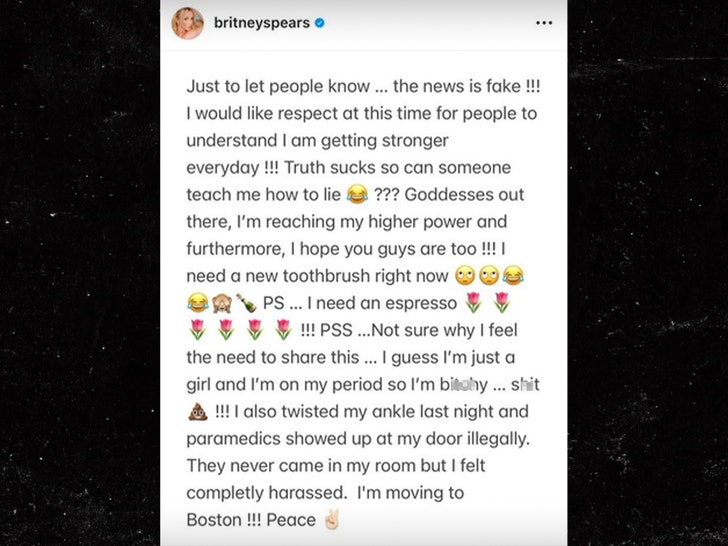
She writes, “Just to let people know … the news is fake !!! I would like respect at this time for people to understand I am getting stronger everyday !!!”
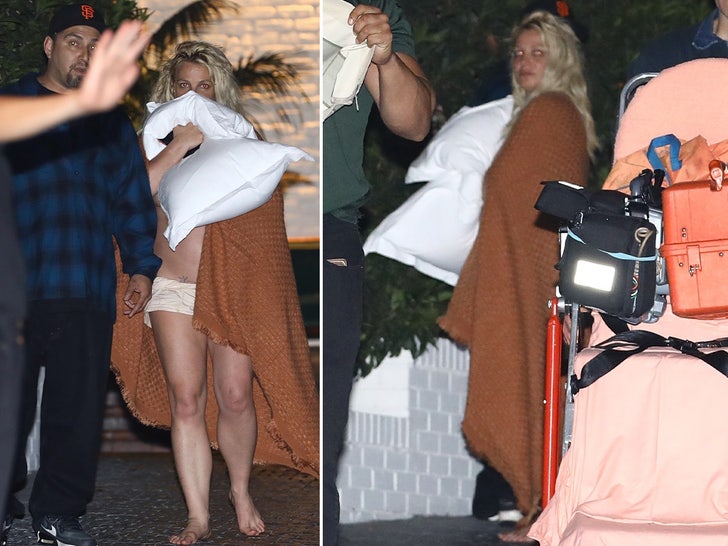
Britney goes on to say this … “Truth sucks so can someone teach me how to lie ???” She continues by explaining what sort of injuries she sustained in the argument — saying she twisted her ankle, and claiming paramedics showed up at her hotel door “illegally.”

She adds, “They never came in my room but I felt completely harassed. I’m moving to Boston!!!”
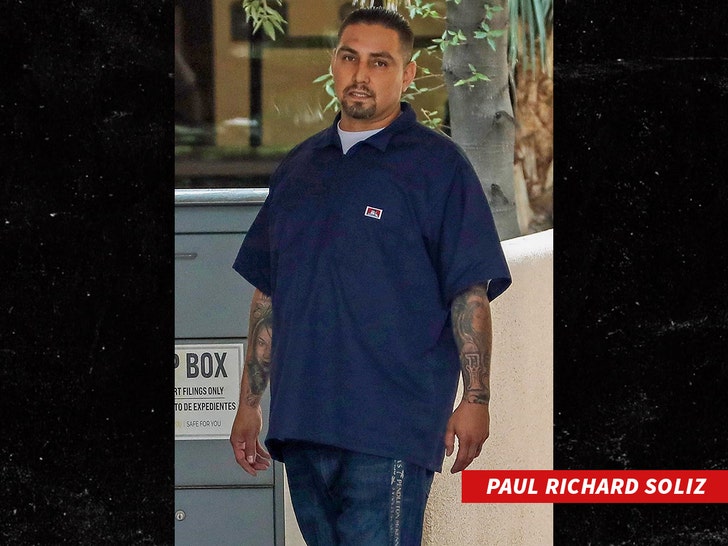
Of course, based on our reporting … we know this isn’t how things went down. As we told you — someone called cops to report a woman matching Britney’s description causing a ruckus at the hotel, allegedly bothering employees and guests.
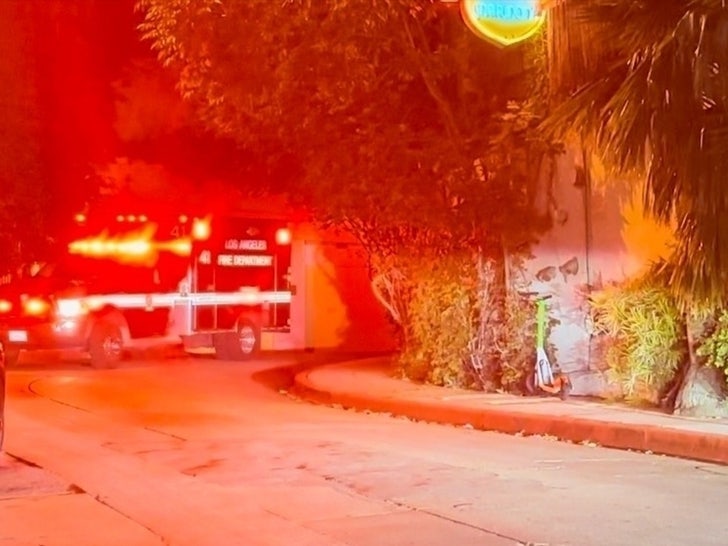
After cops showed up and didn’t see anything was amiss — we’re told Britney and Paul hit their room, kept partying and eventually got into a scuffle … which ended with her getting injured. Paramedics were eventually called, but Britney wasn’t stretchered out.
Instead, she walked out of the building on her own two feet — but was looking rough. We’re told she didn’t leave with Paul, nor did she take an ambulance ride. She left with security.

Now, Britney is trying to downplay the whole thing — but it was ugly, no question. Of course, the larger backdrop is the fact we’ve been told she’s completely dysfunctional right now.
Lifestyle
Elisabeth Moss embraces her best role yet as a secret agent in 'The Veil'

Elisabeth Moss plays British spy Imogen Salter in The Veil.
Christine Tamalet/FX
hide caption
toggle caption
Christine Tamalet/FX

Elisabeth Moss plays British spy Imogen Salter in The Veil.
Christine Tamalet/FX
The new FX on Hulu series The Veil is a spy show about several different spy agencies – from the United States, England and France – all after the same goal. They want to discover the details of a suspected new Sept. 11-type terrorist plot, reportedly emanating from the Middle East, and stop it before it happens.
Sometimes these organizations work together – sometimes they work against one another. But throughout, the agent who is most crucial to cracking the case is a British superspy temporarily going under the name of Imogen. She’s played by Elisabeth Moss, of Mad Men and The Handmaid’s Tale, and by the end of the six episodes of The Veil, I was convinced that this is Moss’ best role, and best performance, yet. She’s amazing.
As a secret agent, Imogen has plenty of secrets of her own, which unfold slowly as the miniseries progresses. She’s a damaged soul with a haunted past – which, for her latest mission, turns out to be a valuable asset. She’s been charged to locate and befriend a woman who recently surfaced in a refugee camp on the Syrian and Turkish border.

The woman, going by the name Adilah (Yumna Marwan), claims to be of Algerian descent, and from France — but several spy agencies suspect her of being the elusive mastermind behind the rumored imminent terrorist plot. Imogen’s mission is to locate Adilah, who is held under guard at the camp after being attacked and stabbed by other refugees. Imogen offers to help Adilah escape, while getting close enough to try to ascertain her true identity, motives and target.

Elisabeth Moss and Yumna Marwan are more alike than either initially suspect in The Veil.
Christine Tamalet/FX
hide caption
toggle caption
Christine Tamalet/FX

Elisabeth Moss and Yumna Marwan are more alike than either initially suspect in The Veil.
Christine Tamalet/FX
The terrorist Imogen is hunting is known as Djinn al Raqqa – in folklore, a shape-shifting genie who can assume any form. Is Adilah actually Djinn al Raqqa hiding in plain sight? Or is she as innocent as she claims? Imogen, a shapeshifter of sorts herself, uses all her spycraft skills to earn Adilah’s trust, by helping her in her quest to cross borders and return to Paris, where her young daughter awaits.
Their journey is fascinating, with each probing to learn the other’s secrets while protecting her own. It’s a bit like Homeland where you, the viewer, are unsure of each character’s true motives. And as the two women go off the grid and spend time with each other, avoiding all the authorities trying to locate them, their relationship keeps deepening.
In that way, The Veil is a bit like Thelma & Louise. Except, sometimes, it’s more like Thelma v. Louise. Both characters are delightfully unpredictable. In one scene, Imogen takes Adilah to a smuggler they hope will give them new passports and identities to get to Paris. Imogen’s plan is to have them pose as singers and belly dancers. But their proposed cover is at risk when the smuggler decides to test them a little by demanding that Adilah display her skills — which she does, leaving both Imogen and the smuggler suitably impressed.
These two actors are incredibly nuanced and well-matched in these roles – captivating as adversaries, and even more so if and when they decide to become allies. The writer and creator of The Veil, Steven Knight from Peaky Blinders and All the Light We Cannot See, explores their relationship brilliantly. But he also keeps escalating the terrorist plot, and following the many agents and agencies trying to crack it. One special standout here is Josh Charles, from The Good Wife and Sports Night, who is cast as an aggressive CIA agent on French soil – an ugly American in Paris. He plays his part perfectly.
Even so, The Veil, at its core, is the story of two shape-shifting survivors who are more alike than either of them suspected – and whose realization of that fact may, or may not, stop a horrifying terrorist attack. It’s quite a voyage – and quite a drama.
Lifestyle
Tarot is everywhere. But her fresh decks are 'a little less caftan, a little more rock 'n' roll'

It’s the first Sunday morning of spring in the Wilshire-Montana neighborhood of Santa Monica and local artist Kim Krans, 43, is making the 10-minute pilgrimage from her apartment to her new favorite place on Earth: the Gloveworx boxing gym at 14th Street and Wilshire Boulevard (which has since moved a half-mile west). “There’s a community here that I just adore,” she says while walking in, wearing an oversized black hoodie and retro fire-red Jordans. Her voice is as soft and calm as it is commanding. She speaks a little like singer and poet Leonard Cohen used to: Each phrase rolls out like a careful mantra, a spell.
Krans can be found at Gloveworx nearly every day of the week, doing mitt work with trainers or going ham on a speed bag. This morning, pacing the floor with swagger as hip-hop blares, Krans looks like the frontwoman of a punk band: She’s tattooed and pixie-like, sporting a ripped muscle tank and a white-blond bowl cut that’s soon stringy with sweat, forming a shield for her ice-blue eyes. Her trainer, Gloveworx owner Leyon Azubuike, 37, is a former heavyweight competitor who has worked with stars like Jennifer Aniston and Cam Newton. He said he trains Krans like a “pro athlete.”
“She’s got the savage and serene.”
— Gloveworx owner Leyon Azubuike
When she first started coming in a year ago, Azubuike remembered thinking: “Oh, yeah. This is my person right here.” He sees boxing as an intensive “mental, physical and even spiritual” practice — and thinks Krans, a longtime student of various other artistic and yogic schools, was primed for it. “She’s got the savage and serene,” he said.
Beyond the boxing ring, Krans is better known as the creative powerhouse behind some of the most influential spiritual art of her generation: a series of tarot-style card decks, under the brand name the Wild Unknown (after the Bob Dylan lyric “wild unknown country”), that have sold more than 1.5 million copies in the U.S. over the last 12 years, according to her own records and those of her publishing company, HarperCollins. Those numbers don’t include all the decks that Harper allows overseas publishers to print and sell internationally in more than 50 countries — where Krans’ work has been translated into seven foreign languages.
Kim Krans shuffles tarot cards in her home.
(Annie Noelker / For The Times)
The first of Krans’ decks, her spin on the iconic Rider-Waite tarot deck of the early 1900s, hit the New York Times bestseller list in 2016. She has since created three sister decks — odes to the animal kingdom and the psychological concepts of “archetypes” and “alchemy,” respectively, deviating from the traditional tarot system and using other symbols as touchpoints for oracle-reading.
Krans now holds four of the top 15 spots on Amazon for bestselling tarot and oracle decks, in a field that has exploded since she entered the market just over a decade ago. This Michigan-born farm girl with classical training as a draftswoman and yogi has become an accidental titan within a larger global tarot and oracle card industry that peaked at a value of around $1.3 billion in 2023 and is expected to keep growing, according to recent market reports released by firms like Verified Market Research.
Tarot card reading, which began as a medieval Italian game and was for many centuries relegated to shadowy psychics’ dens and occult shops, has become a common tool for self-discovery — a ubiquitous part of the ballooning self-care and personal-growth movement, available at book, gift and grocery stores everywhere. The catchy words and images in Krans’ decks, in particular, have brought the practice alive for new generations as a fun, easy way to navigate one’s inner world. Now, after years as an icon of modern tarot, Krans has built a fandom that’s primed to follow her out of the bookstore and into ever-more-abstract realms of spiritual art.
The tarot boom
Old-school tarot decks like Rider-Waite have seen sales increase exponentially over the last decade, according to the deck’s publisher, U.S. Games Systems. Meanwhile, in that time, thousands more spinoff oracle decks like Krans’ have been published across the world, according to Jessica Hundley, 53, a Highland Park writer and editor who created Taschen’s “The Library of Esoterica” coffee-table book on tarot.
“It’s an esoteric renaissance for sure — a ‘new witch wave,’ so to speak,” Hundley said. “As people leave traditional religious structures, they are using different tools and resources to connect to spirit and to self.”

(Annie Noelker / For The Times)
The desire for spiritual discovery paired with the isolation of the pandemic created the perfect alchemy for a tarot boom. Alison Crowley, a spokeswoman for the publisher behind Rider-Waite and other popular tarot decks, said the start of the pandemic in early 2020 took the industry to another level, kicking off a “great uptick” in deck sales that has persisted for years now.
“People were discovering tarot as a self-inquiry tool, and not just this old-school thing to keep in the closet or not talk about,” she said. “It started to come into the mainstream.”
Within this booming ecosystem, Krans is the unlikely cover girl of 21st century fortune-telling. Barnes & Noble stocks her decks at most of its 600-plus U.S. locations and reports selling thousands of copies per year. Oregon chain Powell’s Books reports them to be “top sellers” that have “stood the test of time” compared with most of the other oracle options on the shelf. House of Intuition too — one of L.A.’s most popular spiritual gift shop chains, with nine locations across SoCal and Miami — carries the full Wild Unknown collection by popular demand, and it has become “quite a staple,” per a spokesperson.
[The Wild Unknown Tarot] has a great kind of witchy darkness to it that I think is missing from a lot of the new-age, more unicorn-and-rainbow decks. It feels … a little less caftan, a little more rock ‘n’ roll.
— Jessica Hundley, author of “Library of Esoterica”
Her tarot and oracle art has inspired legions of social-media tributes — at least 100,000, of the posts that are tagged on Instagram. Dozens of them show her art inked permanently onto fans’ skin.
“The first time that I saw a tattoo on Instagram, I had an out-of-body experience where I could see the trajectory of the deck,” said the artist, speaking to The Times from her black-and-gold sanctuary of a workspace, carved into the corner of her sunny, second-floor apartment.

Memorabilia in Kim Krans’ Santa Monica apartment.
(Annie Noelker / For The Times)
Behind her is a row of copper urns with mystery objects inside (an old art project) and a bejeweled Mother Mary portrait she salvaged from a barn in rural Pennsylvania. Stacks and scrolls of Krans’ paintings and word art, many of them odes to the planets, are stuffed into every cranny of the office. Yet the only Wild Unknown deck on her bookshelf is the very first she printed — her “OG deck,” as she calls it, its box now lathered in black paint.
“I knew that someday it would be on Amazon, that someday it would be in multiple languages,” she said about that original deck. “And I knew that my job was to be its guardian.”
Art kid hits big
Krans’ fresh take on the tarot in 2012 launched a “new era” for the ancient art form, per tarot expert Hundley. Hundreds of other artists soon followed suit, emboldened by growing demand and the democratization of digital printing.
But the Krans aesthetic is unique for its rebellion against the typical perky, pastel look often used on yoga mats and reusable water bottles — even though her work can be spotted on the shelves and shrines of influencers across the wellness industry.
The Wild Unknown Tarot is “very punk and goth in some ways,” Hundley said. “It has a great kind of witchy darkness to it that I think is missing from a lot of the new-age, more unicorn-and-rainbow decks. It feels … a little less caftan, a little more rock ‘n’ roll.”

(Annie Noelker / For The Times)
Before she became the face of nouveau tarot, Krans spent years studying and creating visual art in Manhattan in the 2000s — then played music with the upstate indie band Family Band, opening for acts like Warpaint alongside her then-husband Jonny Ollsin, a heavy-metal guitarist. By 2012, broke and disenchanted with the New York scene, Krans moved into a renovated church in Philadelphia. She was craving something more, artistically and spiritually, and was drawn to the centuries-old tradition of tarot.
But Krans couldn’t quite connect to the major deck on the market, the Rider-Waite set from the turn of the 20th century. She decided to reimagine the harsh, human images in the traditional deck (think kings, queens and swords sticking out of bodies) as scratchy line drawings of plants, animals and other earthy symbols under moody skies, lit with pops of rainbow paint — her now-signature style. Krans said she used a $5,000 loan to print 1,000 copies on a local press.
“You’ll find no wrongs or rights inside this box, only mirrors for reflection,” she etched in loopy cursive inside the lid. “Open your mind, draw a card & have fun on your journey.”
The deck included a guidebook with simple instructions on how to do a handful of classic tarot readings — plus a page for each card, explaining in plain language what it might say about the psyche and reality of the person drawing it. Pull the dreaded “Death” card, and one was met with compassion, in the voice of a friend. This time she wrote her messages in a childlike sans serif that a designer friend of the artist later turned into a custom font, for more efficient printing. They called it “Krans Sans.”
Almost immediately, in the fall of 2012, Krans said a scout from the bohemian boutique Free People — a subset of the multibillion-dollar hipster emporium Urban Outfitters — reached out to her and placed an order for 100 units. Trendy NYC boutiques like Catbird starting stocking them that year too. “The deck appeared on New York Magazine’s ‘approval matrix’ and momentum snowballed,” Krans said.
By the following year, she said “it was just a matter of trying to keep them in stock.” In 2014, Krans moved to Topanga Canyon in L.A. — a period she calls her “botched Malibu dream” — and became a “highly pressurized kind of workaholic,” deep in the practice of self-publishing. By the time Krans handed off her tarot deck to HarperCollins in 2016, she said she had already moved a quarter million decks on her own, largely through 200-plus “specialty market stores” across the globe and the Urban Outfitters machine.
Around the same time, Wild Unknown Tarot hit the New York Times bestseller list — and, in the process, a businesswoman was born.
Commercial rebellion
Krans was initially embarrassed by this level of mainstream success. But as she began to see her decks’ impact on young fans, the burgeoning business owner, in her words, got “so psyched.” One of her mantras during the early days became something she’d heard Kurt Cobain say, early on in his success: That he wanted his CDs in Walmart, despite it being a corporate behemoth, because that’s the only place some kids could access his music. She began to see her commercial sales as a form of rebellion. She said in a recent podcast interview that she’d remind herself to “just be more like Kurt Cobain. F— the machine.”
It follows then that Krans has done for the shadowy world of tarot what Nirvana did for the underground punk scene: make a dense art form relatable enough to bring its spirit alive for the masses.
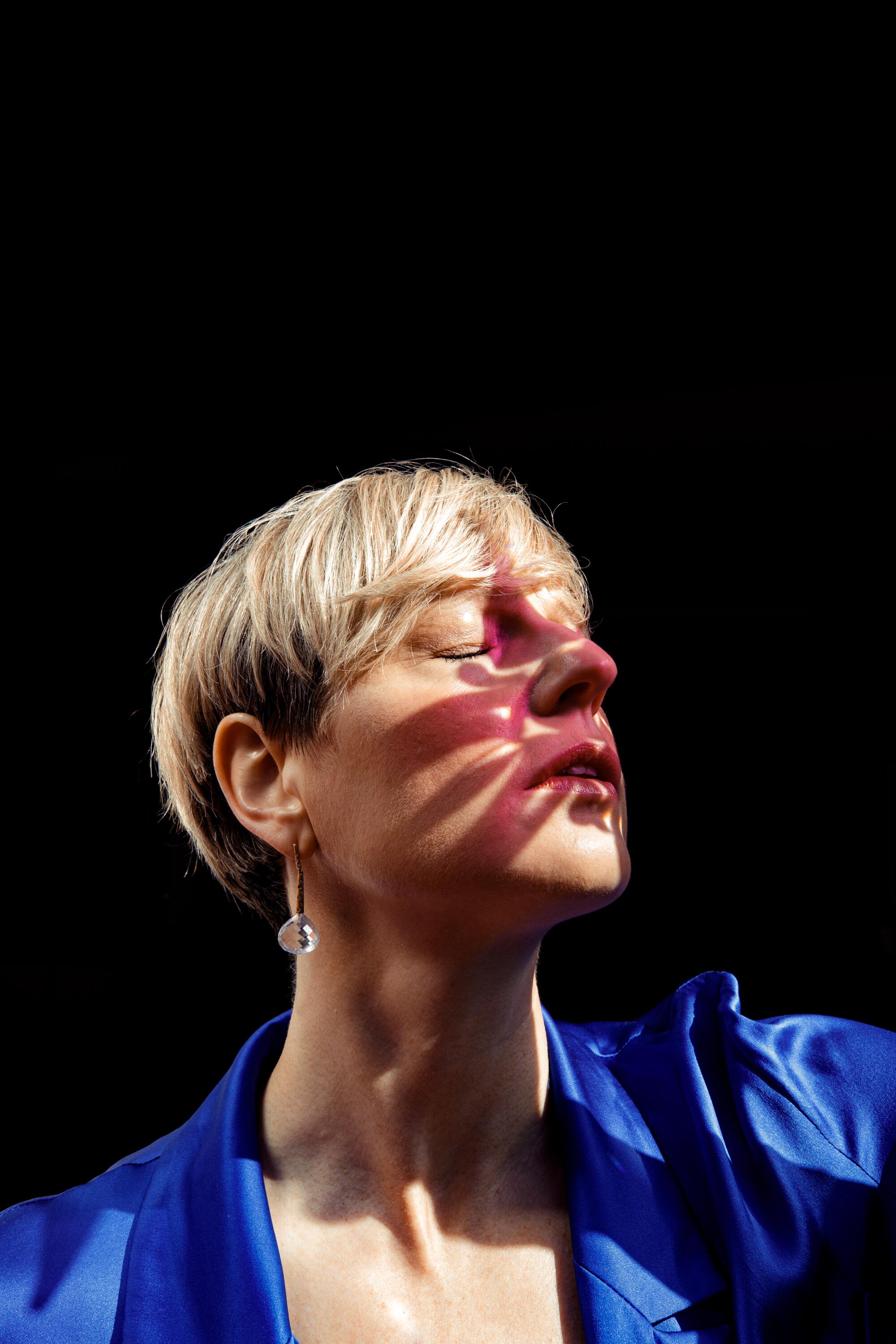
(Annie Noelker / For The Times)
Her tarot “spoke to young people in a different way,” said Crowley of U.S. Games Systems. “She had her own voice. The other thing was that young people were just ready to come in. It was the right timing.”
A 2016 Buzzfeed article rounded up Tumblr posts from superfans who had inked Krans art onto their bodies. Many of them said that although her deck was often their first encounter with tarot, they felt immediately comfortable playing with it.
“I could not believe the response to it,” Krans said. “I was thinking, ‘Well, yeah, tarot is powerful. But what is going on here? Why is it speaking to people so universally, and so deeply and immediately?‘”
Krans developed a theory about the popularity of that first deck. Although she had modernized the depiction of tarot’s “archetypes” — or patterns that live in the human psyche and serve as a filter for reality — those ancient patterns remain as powerful as ever.
The 22 main archetypes within the tarot are called the major arcana (think characters like “The Magician” or “The Star”). And, per Hundley, each one is “contained within all humans and expressed through our emotions.” The 56 minor arcana cards — which mirror the pattern of common playing cards — represent “daily challenges and opportunities.” Together, she said the cards form a map of the “various influences and energies at play in our lives.”
By giving these archetypes the shape of animals, like “The Fool” as a duckling teetering on a twig, “The High Priestess” as a regal white tiger or “Justice” as two house cats — as opposed to the human characters of the classic Rider-Waite deck — Krans said she noticed her cards were helping people “get into the archetypes in a more universal, intuitive way.”
Honed by data
This intuition birthed a 2016 follow-up project that would become one of Krans’ top sellers: Animal Spirit, the second oracle deck of the now-four-part Wild Unknown series. Its box was cloaked in shimmering, hand-drawn reptile scales. A yellow dragon’s eye stared out from the center. Each animal in the guidebook came with a quick list of its light and dark qualities, plus some tips from Krans on how to play off their archetypal traits for better living. If you’re dealing with out-of-balance Bat energy like “refusing to let go,” for instance, you could “watch the sunrise.”
To find the right words and images for the deck, those which would be “most useful for people at this time,” Krans said she held multiple rounds of focus groups — a process she repeated for the two decks that followed. “I would have people over to the studio, and I would record their response to looking at the cards,” she said. “I was collecting data.”
Krans sees business instincts like these as her “Saturn energy” — a structured, disciplined side that stems from her blue-collar upbringing as the daughter of a truck driver and an elementary-school secretary in Skandia, a tiny Scandinavian farm town in the rugged Upper Peninsula of Michigan.
“A big priority for me is to stay really practical,” Krans said. “Everyone in L.A. wants to diss Saturn. It’s a conspiracy against Saturn. I’m like, first of all, you guys are crazy. Second of all, try to get a book done without some discipline.” She paused, then continued: “You have to have that side, as a creative and as a seeker, that is like, ‘OK, let’s hone it.’”
Everyone in L.A. wants to diss Saturn. It’s a conspiracy against Saturn. I’m like, first of all, you guys are crazy. Second of all, try to get a book done without some discipline
— Kim Krans, creator of the Wild Unknown oracle deck series
These days, the cards of Animal Spirit can be spotted in still lifes and spiritual flexes all over social media. This past holiday season, actor Jessica Biel shared a snapshot of two cards from the deck, Buffalo and Swan, with her 14 million Instagram followers. “More of this in 2024,” she wrote.
Much like the Wild Unknown Tarot deck, Animal Spirit began with a self-published release of 50,000 decks, Krans said. HarperCollins snatched that one up, too, and rereleased it in 2018, during a short stint when Krans was living in Venice Beach, newly divorced and “trying to be a single surfer and dancing.” Krans said that come 2021, Animal Spirit was neck-and-neck for sales with her original tarot deck for the first time — a trend that held in 2022 and 2023. Total sales are now approaching half a million, according to her records and HarperCollins’.
Once Animal Spirit was in the world, Krans kept creating. She knew there was more to learn about why her tarot and animal cards were flying off the shelves. So she enrolled in the Pacifica Graduate Institute (just south of Santa Barbara) and entered into formal study of “depth psychology and creativity” through the lens of Swiss psychologist Carl Jung.
“That’s when I found that, if tarot is a car that you’re riding in, archetypes are the engine,” Krans said.
Weirder and wilder
Just like that, a third Wild Unknown deck was born, the one she now considers the “mother” of the series: Archetypes, released by Harper in 2019. Its 78 circle-shaped cards expanded on the 12 archetypes outlined by Jung over the course of his career, as well as the 22 in the tarot tradition, to include places like “The River,” characters like “The Siren” and “initiations” like “Apocalypsis.” The deck’s whopping 223-guidebook included a full personal and historical rundown of the concept of archetypes, which by now had Krans obsessed.
In place of offering life advice like she did in her previous deck, she urged readers to explore art like Bruce Nauman’s neon sign “The True Artist Helps the World by Revealing Mystic Truths.”
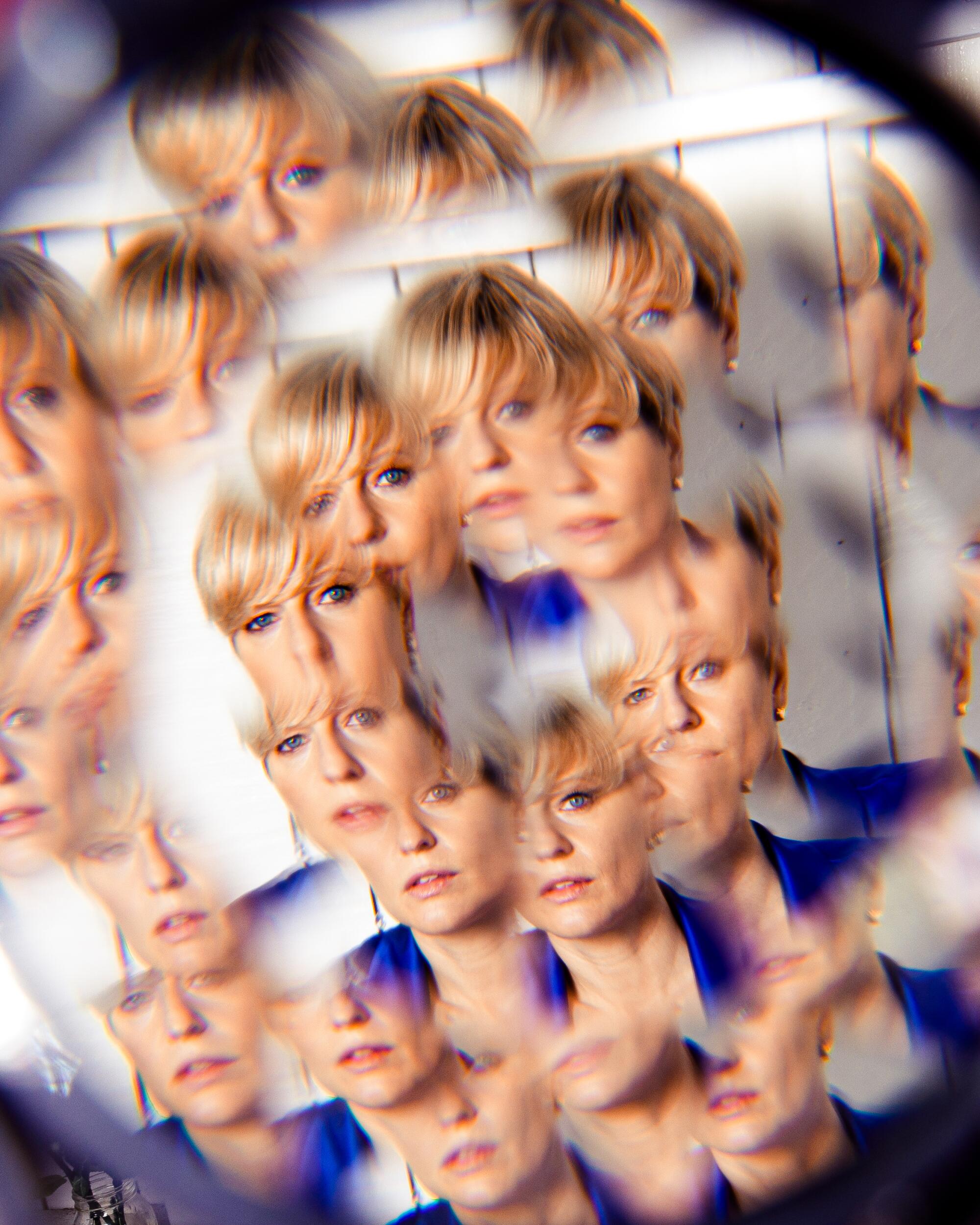
Kim Krans
(Annie Noelker / For The Times)
Web searches for the word “archetype” have been steadily rising in the United States since Google began tracking search trends around two decades ago, and appeared to reach an all-time high last summer. (Thanks in part to the word’s increased usage in pop culture and online conversation.)
Meanwhile, sales for Krans’ once-obscure Archetypes deck began to climb in 2023, according to numbers provided to the artist by her publisher, HarperCollins. The company also pushed a miniature “pocket” version of Archetypes in early April, as it had done for the tarot and animal decks in previous years . It feels like an indication, Krans said in a recent Instagram live, that “the concept of archetypes is starting to get mainstream.” In the video, she showed off the tiny new cards to followers, delighted: “You could bring this to Coachella. You’re like, ‘I have my phone, I have gum and I have Archetypes.’”
In 2022, Krans released the final and so-far least popular oracle deck in the Wild Unknown series, which she calls “the freaky one”: Alchemy. It drew on another of Jung’s central theories about the way the mind works, and served as the culmination of Krans’ own exploration of the Swiss psychoanalyst’s school of thought. The 71-card, 231-page Alchemy deck is a clear COVID project — a swirling study of the materials, both visible and invisible, that power our world, and how they might be better understood or even manipulated to serve.
It was the end product of “seven, eight years of drawing decks, and a lot of self-inquiry and scholarly pursuit of like, ‘What is this? What are these personal forces?’” Krans said. In her metaphor where tarot is a car and archetypes are its engine, she now thinks of the elements of alchemy as the engine’s fuel.
An industry skeptic
In recent months, the inadvertent queen of tarot has been shape-shifting through more iterations of artistry and identity. “I’m now entering Act 2,” she said, post-workout on her Santa Monica stoop.
Much of this new era involves movement, performance and sound. Krans leads occasional yoga nidra sessions at the kundalini-focused Ra Ma Institute on the Westside, where she guides followers into the same “slippery, lucid state” that births her own creations. She also returned to music this year with the hypnotic, harmonium-heavy album “Mirror Mirror” — picking up where she left off in the early 2010s. The album is filled with mantras and other sonic tools she uses in her own spiritual practice as a way to induce trance and lead people into the dreamworld.
“Drawing, although it’s like my home base, it’s not enough,” Krans said in a podcast interview. “I need the sound. I need the scale of the drawing to be able to grow and expand.”
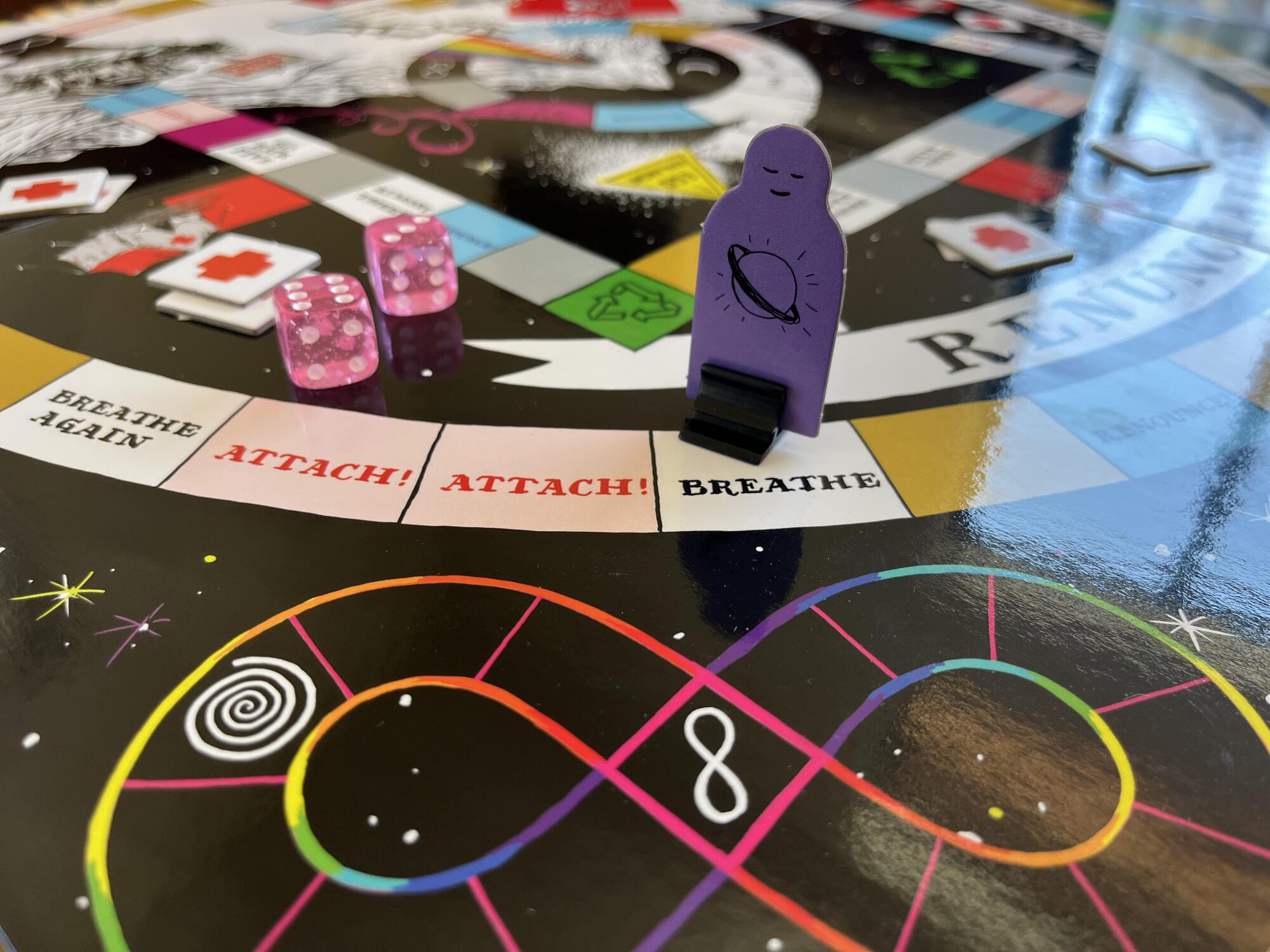
Kim Krans new board game, “Renunciation.”
(Simone Wilson)
Last fall, Krans also released a mandala-shaped board game called Renunciation after studying game design for more than a year with a group at New York University. The game pieces are archetypal characters like “pop star” and “school principal”; the setbacks, attachments like coffee and hairdos; the course, a trail to a Himalayan cave; the goal, enlightenment.
To win, players must rid themselves of all attachments and, eventually, their name and identity. Meanwhile, “you’re backstabbing all your enlightenment-seeking opponents on the way to enlightenment,” Krans explained — a riff on competitive spirituality. “So L.A.,” she said.
Recently, Krans has turned to comedy as an outlet for her disillusionment with the wellness industry, which she feels can get “so freaking serious” — and in many ways stay surface level — about things like personal growth, astrology (“people use it to evade so much stuff”) and reaching higher states of consciousness. She said she’s celebrating a resurgence of the “prankster and performer” in her, a side she said was shut down during her time both in art school and the new-age wellness industry. In May, she’ll poke fun at the scene with an “interstellar” stand-up show at the Culver City Comedy Club, under the stage name Kimmy K — a nickname given to her by her boxing coach.
“I feel like in some ways, there’s nowhere left to go but comedy,” she said.

Kim Krans
(Annie Noelker / For The Times)
During an L.A. Times photo shoot in her Santa Monica home, the artist — dressed in bright-blue sweatpants and stilettos — practiced some material, adopting the role of a TV psychic by play-hosting a “tarot dial-in” during which she took fake calls on a shiny red telephone.
One of the bits she’s been chewing on is called “leave your oracle alone.” It’s about “not doing a tarot reading when you already know the answer to the question,” she said. “Like, if you know the guy is a douchebag … if everyone in the room could answer but you … leave the oracle alone.”
Watching her play, humor starts to feel like an end stage of study for the punky L.A. yogi who made her abstract, Carl Jung-inspired art — the weirdest stuff on the shelf at Urban Outfitters — just accessible enough, at just the right moment, to infiltrate popular culture and give spiritual dabblers a doorway to follow her deeper down the spiral of the psyche.
-

 News1 week ago
News1 week agoLarry Webb’s deathbed confession solves 2000 cold case murder of Susan and Natasha Carter, 10, whose remains were found hours after he died
-

 Education1 week ago
Education1 week agoVideo: Dozens of Yale Students Arrested as Campus Protests Spread
-

 World1 week ago
World1 week agoHaiti Prime Minister Ariel Henry resigns, transitional council takes power
-

 News1 week ago
News1 week agoFirst cargo ship passes through new channel since Baltimore bridge collapse
-

 World1 week ago
World1 week agoUS secretly sent long-range ATACMS weapons to Ukraine
-

 World1 week ago
World1 week agoSpanish PM Pedro Sanchez suspends public duties to 'reflect'
-

 News1 week ago
News1 week agoAmerican Airlines passenger alleges discrimination over use of first-class restroom
-

 World1 week ago
World1 week agoAsia bears biggest climate-change brunt amid extreme weather: WMO













